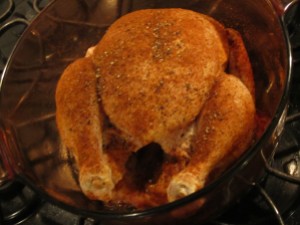There is so much misinformation out there about simple cooking topics, that it isn’t surprising that people are CONFUSED. So today I am going to address a topic I get asked about constantly. Really. In fact, I just got asked AGAIN the other day…HOW do you cook a chicken and how do you know when it is done?
The absolutely best poultry cook I know is my sweetheart, Steve, who I am happy to report got pulled off the singles market by yours truly. 🙂 However, before he met me, he had to fend for himself and he developed a technique for cooking chicken that is- hands down- the simplest and most delicious method for cooking a chicken. All of the credit goes to him. I get none. Zip. Nada. But before we begin, a couple of basics.
Whole chickens come in two basic types at the store: stewers and roasters (sometimes called broilers or fryers.) Stewers are older birds that have finished laying eggs and are tough and stringy. The meat will have to be cooked in a stew (liquid) over a long period of time to break down. You get the idea. The others are much, much younger and the name indicates (usually) the size and age of the bird, but in no case are the birds over 4 months old and can be as young as 6 weeks old. (Try not to think of them as baby birds…it helps to think of them as TEENAGE birds! That makes it much easier! Bwahahahaaaa! Ok, now where was I?) Since you will be using dry heat to bake the chicken, you will be selecting a roaster at the grocer.
What if your chicken is frozen solid? You have a couple of options.1. Put the frozen chicken into a bowl and put it into the refrigerator for several days to defrost, or 2. Put the chicken into a large bowl of COLD water. Why cold water? Warm water invites the growth of micro-organisms (ie; food poisoning)- never a good idea when it comes to making dinner! The cold water will speed up the thawing of your chicken. Why not just put the chicken into your sink and fill it up with cold water? Uh, your sink is one of the filthiest places in your house according to research. Do you really want to put your chicken in there now?
Now that you have a thawed chicken, take it out of its package, pull the package of giblets out of the center cavity and rinse the chicken out. At this point I usually take a pair of scissors and cut off all the extra hunks of fat hanging out inside or around the openings of the chicken on the premise that there is plenty of fat in the skin and we don’t need any more. Shake the extra water off and put the whole chicken into a large baking pot that has a lid. Old Bay Seasoning is now going to become your new best friend. Liberally (and I do mean liberally) shake that Old Bay all over the outside AND inside of the chicken. Top with a bit of fresh ground black pepper and put on the lid. Note: there is NO added liquid. Place the chicken into a preheated 425 degree oven and set a timer for 30 minutes.
At the end of 30 minutes, take the chicken out of the oven and move it around in the baking dish as it will want to stick to the bottom of the dish. If there is any juice at this point, spoon a bit on the top of the chicken, put the lid back on, put it back into the oven, turn the oven down to 375 degrees and set the timer for 20 minutes. Do the baste and turn routine three more times and dinner is ready. Start to finish, the chicken takes about 1 1/2 hours to cook and it will be golden brown and falling off the bone tender and juicy.
While the chicken is baking, scrub a few baking potatoes or sweet potatoes and put them in the oven with the chicken after the first 30 minutes as potatoes take 45 minutes (approximately) to cook. Sweet potatoes will need to be wrapped in aluminum foil or they will drip all over the oven and make a huge mess. You can also make a salad, set the table and when the chicken is done, everything else will be ready. Easy peasy!
So how do you know when a chicken is done? If you have a meat thermometer, insert the thermometer into the meaty part of the thigh. It should read 165 degrees. What if you don’t have a meat thermometer? After all, my grandmother was an amazing (and safe) cook, she NEVER used a meat thermometer, and I can only guess what she would have had to say about my insistence on her using a meat thermometer! So what did she do? Heh. Simple. Poke the chicken with a knife between the thigh and the body. If the juices run red…the chicken is NOT done. If the juices run clear, the chicken is done.
And finally, what’s all this about salmonella and chicken? Good question. Who wants to get sick, right? Salmonella is a serious disease caused by bacteria found in the intestines of animals, including chicken. A few safety precautions will keep you and your loved ones safe. First, if you are cutting chicken up on a cutting board, be sure to use common sense and do NOT use the same cutting board to cut up your salad later. Ugh. Soap and water is required for ALL surfaces that raw poultry have touched. Keep meat separate from veggies and fruits in your fridge for the same reasons. Finally, salmonella is killed by cooking poultry to an internal temperature of 165 degrees or…until the juices run clear.
See…Cooking is simple and you can do it!

